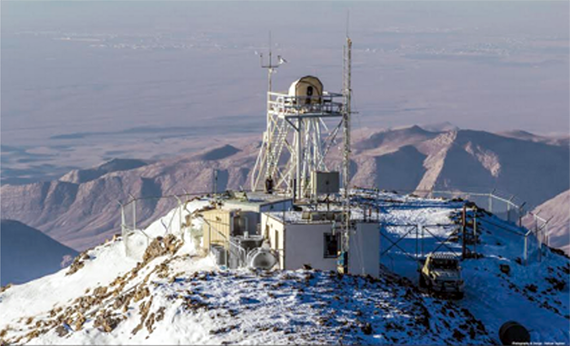Altitude 3600m Built Under Construction | Wavelength Optical First light est. 2020 | |
 | ||
Organisation Iranian National Observatory Location(s) Iranian National Observatory(INO), Gargash Peak, Isfahan, Iran Similar Science & Astronomy center of, Maragheh observatory, Museum of the Qasr Prison | ||
Iranian National Observatory (INO) aims at construction of observing facilities for astronomical research and education purpose. The primary goal is the design and construction of a 4m-class optical telescope and other smaller observing facilities to respond to a growing demand. INO is executed at the Institute for Research in Fundamental Sciences (IPM), one of the leading research institutes in fundamental sciences.
Contents
Background
The current research and training capabilities in observational astronomy in Iran is unable to meet the growing demand due to a rapid growth in higher education over the past two decades. While almost every big university in Iran has an astronomy department or group, the existing observational facilities consists of a number of small telescopes in various university campus observatories generally used for undergraduate and graduate training.
A medium size optical telescope is thought to be a step to facilitate research in astronomy and observational cosmology. The geographic location of Iran, 32N 53E, relative dry climate and high altitude mountains, offer suitable locations for optical telescopes to carry out surveys and time critical observations.
At the present the flagship of the INO observing facilities is a 3.4m optical telescope under construction, known as INO340.
Site Selection
The site selection activities began in 2000 before even the formal approval of the project in 2004. With two sites in hand after the conclusion of the site selection (2000–2007) INO made DIMM measurements to be able to compare the two sites, Dinava ~3000m and Gargash ~3610m. In 2011, INO announced "Gargash" as the selected site for this project.
Telescope Design
Optics
The telescope is a Ritchey-Chrétien f/11 which provides unvignetted 20 arcmin filed of view at the main Cassegrain focus. In addition 3 bended focus are also provided each with a field of view of 8 arcmin. The main mirror (M1) is single segment fast f/1.5 mirror with a diameter of 3.4m, which makes IN340 one of the most compact telescopes at this size. M1 is a meniscus shape 18 cm thick made of a Zerudor ceramic with a 700mm central hole. The M1 is polished to 1 nm roughness. The M1 is supported by 60 actuators which are actively or passively (lookup table) controlled to keep the mirror shape undistorted under its own gravity at different pointing. The 600mm secondary mirror reflects the light from the primary mirror and is also controlled by a hexapod. The mirror has is made of a Zerodur ceramic and has a hyperbolic surface geometry.
The structure
The telescope mount is altitude over azimuth (alt-az) which allows the telescope to be very compact (relatively speaking) and provides direct load paths from the telescope down through the structure to the pier and foundations. The drive motors used to move the telescope in azimuth and elevation will be servo motors with position feedback will be provided by linear tape encoders.
Telescope Control System (TCS)
The TCS is responsible for controlling a number of subsystems, such as the mount control system (MCS) which is responsible for pointing and tracking the targets and the mirrors control system or active control systems (ACS). MCS receives commands from the user interface.
Site Monitoring Facility
The INO site monitoring station has become operational in Nov 2014. The station is located around 500m to the south east of the main Gargash peak where the 3.4m Telescope is planned to be constructed. The site monitoring station is equipped with an automatic DIMM seeing monitor at a height of 6m above the surface of the mountain, remotely operated from Tehran. The station also includes a standard weather station. The control system is designed in-house.
Science with INO
A vast amount of scientific issues in observational astronomy and cosmology can be addressed using a medium class telescope such as INO 3.4m telescope. At the same time, as it is designed for a wavelength interval limited to between 325 and 2500 nm, INO340 is an excellent tool for collaborative programs joining other, major, similar size and/or larger telescopes as well as with space-based telescopes optimized to work at similar or different, not least very different, wavelength ranges.
The study of galaxies and our current understanding of the formation and evolution of the large and small scale structures are, to a large extent, based on the observations carried out by mid-size telescopes. Even at the era of large and very large telescopes, such observations are still pursued thanks to advances in the instrumentation. While there are new frontiers to be explored by very large and extremely large telescopes, there are still enormous details which require further explorations. For economic and flexibility reasons there are still demands for 2‐4m class telescopes. These telescopes can complement others observing facilities to address some of the most fundamental questions related to galaxies such as the evolution of the cosmic web of galaxies, metal production and distribution within and between galaxies, formation of the present day Hubble sequence and also understanding our own galaxy.
For the community of astronomers in Iran, extra-galactic astronomy and observational cosmology is a new undertaking mostly because of the absence of suitable observing facilities in the past and thus INO340 will focus on this line of developing research. Taking advantage of the location, INO340 is designed to respond to time critical astronomical events. Large programs and surveys are also pursued in instrumentation planning.
